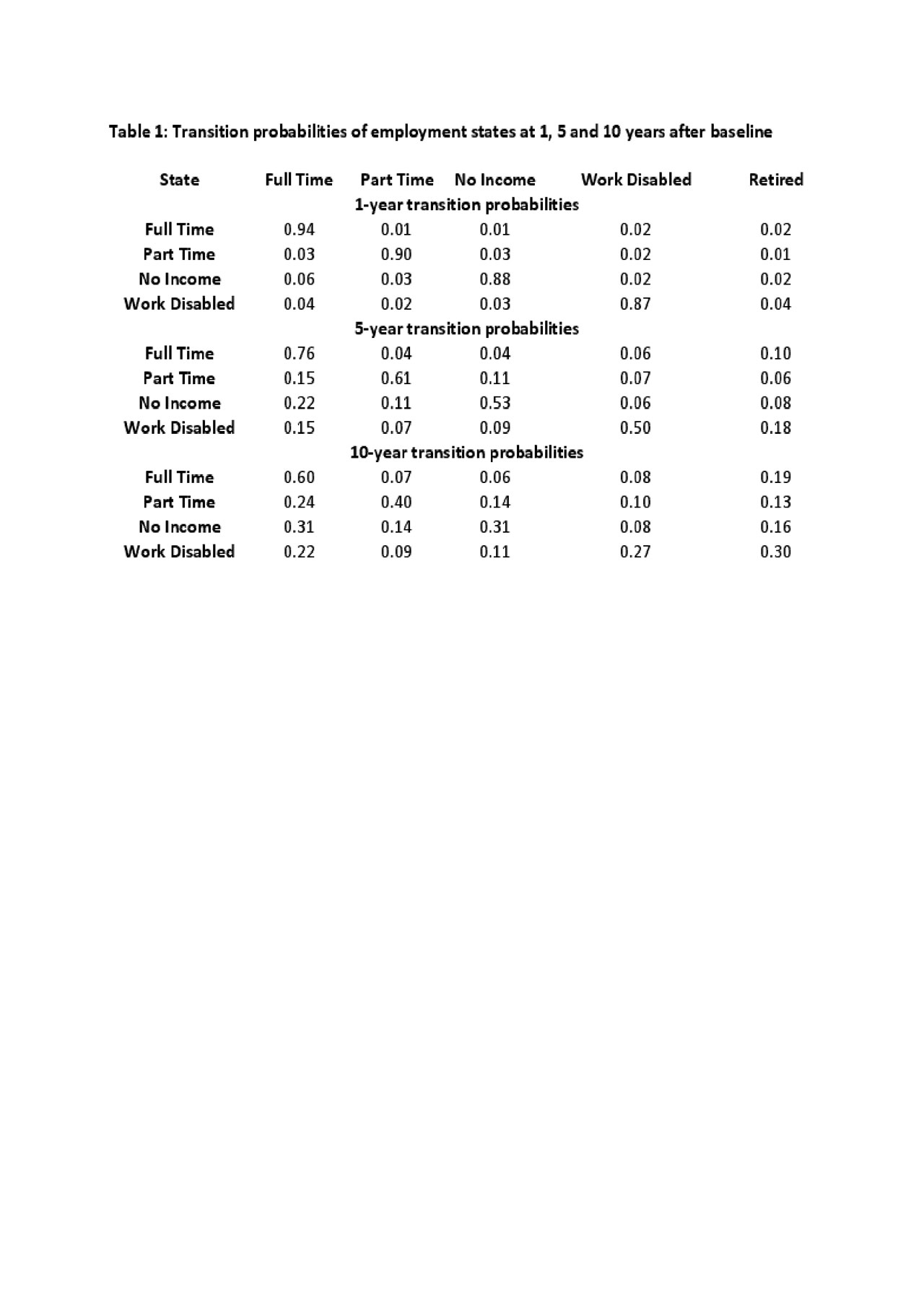Session Information
Date: Monday, November 11, 2019
Title: RA – Diagnosis, Manifestations, & Outcomes Poster II: Treatments, Outcomes, & Measures
Session Type: Poster Session (Monday)
Session Time: 9:00AM-11:00AM
Background/Purpose: Historically, increasing proportions of patients with rheumatoid arthritis stop working on long-term follow-up, often due to arthritis. The trajectory of work transitions in early arthritis in the era of targeted treatment is unknown. Since decreasing employment may lead to loss of employment or work disability, we aimed to delineate the longitudinal transition trajectory of early arthritis patients and to identify predictors of decreasing employment.
Methods: This is a single center retrospective inception longitudinal cohort study of early inflammatory arthritis (EIA) patients whose symptom-onset£1 year at diagnosis. Patients were treated to target remission. Disease activity score 28 (DAS28– 3 variables), and patient reported outcomes were collected at each visit. Work status has been recorded annually. The primary outcome was employment states: full-time (FT), part-time (PT), unemployed, homemaker/ student, work disability (WD), retired (RE). We used the Markov multistate model, adjusted for interval censoring, to model the longitudinal transition trajectory of employment. The states in the model are: FT, PT, no income (NI: unemployed, homemaker & students), WD (self-reported) and RE (the only absorbing state). Probabilities of employment were calculated. Candidate predictors, both time-invariant and time-varying, including: sociodemographics, EIA activity, patterns of joint involvement (large upper or lower extremity joints, small upper or lower extremity joints), functional capacity (health assessment questionnaire, HAQ), quality of life (Short Form 36, SF36) and self-reported comorbidities (other chronic diseases, mental illnesses) were tested for association with employment transitions.
Results: 312 patients (76.5% females) diagnosed from 2000-2017, who were not retired at the baseline visit, had a median age at diagnosis was 45.3 years (33.3– 52.7, 25th-75th percentiles P), median duration of follow-up was 4.3 years (1.1– 9.8, 25th-75th P), median baseline DAS28 of 4 (2.9– 5.1, 25th-75th P) and 48% were rheumatoid factor positive. At baseline, 51% were working FT, 14% PT, 7% were students, 13% were homemakers, 8% WD. Baseline median completed school years was 12 yrs (12-15, 25th-75th P). Patients were most likely to stay in the same state of employment they were in at baseline, at 1, 5, 10 yrs (Table 1). Probabilities of transitioning to a FT/PT state from baseline NI increased to 0.33 (5 yrs) and 0.45 (10 yrs) and from baseline WD increased from 0.22 (5yrs) to 0.31 (10 yrs). Older age was protective of transitioning from PT to NI (hazard ratio, HR 0.87; 95% CI 0.82-0.93). Increased fatigue was associated with increased transitions from PT to NI (HR 1.02, 95%CI 1.00-1.04). Better SF36 was protective of transition from FT to WD (0.92, 95% CI 0.86-0.98). Sex, education, arthritis features, comorbidities & mental health were not associated with employment transitions.
Conclusion: Employment states in EIA patients changed dynamically over time. Even individuals who had NI or were WD at diagnosis had increased probabilities of moving into a working state over time. This work identified potential targets for intervention strategies to help EIA patients gain or regain employment.

Table 1_ERA_TransitionStates_ACR
To cite this abstract in AMA style:
Lim L, Cheung D, Mohamed K, Lacaille D, Pullenayegum E, Hitchon C. Longitudinal Work Transitions in Early Inflammatory Arthritis Patients: Are There Targets for Intervention to Improve Employment? [abstract]. Arthritis Rheumatol. 2019; 71 (suppl 10). https://acrabstracts.org/abstract/longitudinal-work-transitions-in-early-inflammatory-arthritis-patients-are-there-targets-for-intervention-to-improve-employment/. Accessed .« Back to 2019 ACR/ARP Annual Meeting
ACR Meeting Abstracts - https://acrabstracts.org/abstract/longitudinal-work-transitions-in-early-inflammatory-arthritis-patients-are-there-targets-for-intervention-to-improve-employment/
